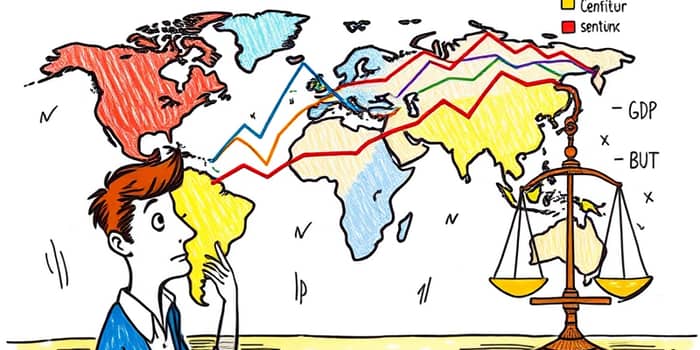
In recent months, a striking phenomenon has emerged: global consumer sentiment is charting a path distinctly separate from GDP forecasts. While economic output figures suggest resilience or modest growth, everyday consumers harbor rising doubts. This divergence presents a profound challenge for businesses, policymakers, and analysts who have long relied on the historic link between mood and macro data.
Understanding this evolving landscape is vital. When sentiment falters, spending slows, investments stall, and trust erodes. Today, more than ever, we need to bridge the gap between objective measures and subjective perceptions to fuel sustainable recovery and growth.
For decades, consumer confidence indices moved in tandem with unemployment rates, inflation trends, and consumption patterns. Economists found that sentiment explained roughly 77% of its own variation from 2005 to 2019. In other words, when GDP increased and jobs were abundant, sentiment followed upward too. Forecast models embedded this correlation, making it almost instinctive to equate rising output with rising optimism.
However, since the pandemic, this once reliable relationship has frayed. Even with GDP growth rates that exceed pre-pandemic forecasts, consumer attitudes have remained muted or outright pessimistic. This shift begs the question: why are consumers feeling disconnected from the broader economic narrative?
Recent data paints a clear picture of this decoupling. The Ipsos Global Consumer Confidence Index for May 2025 sits at 47.4, down from last year. In the United States, sentiment has plunged by over seven points in six months, despite a 2.8% rise in private consumption during 2024. Q1 2025 even registered a quarterly contraction in US real GDP, yet confidence indices diverged further.
Global indices and regional readings tell similar stories: China and India remain relative bright spots, while Europe and North America wrestle with pronounced caution. The table below summarizes key metrics that underscore how sentiment and economic output have drifted apart.
This evidence makes it clear: we can no longer assume that rising GDP equals rising confidence. Instead, a new narrative of separation has taken hold.
The unraveling of historic correlations stems from a confluence of factors that extend beyond raw economic performance. Among the most influential are:
These forces combine to distort how consumers interpret their personal situations relative to broader trends. Even when objective indicators improve, the lingering emotional resonance of past shocks dampens confidence and frays optimism.
As sentiment diverges from GDP, decision-makers must recalibrate strategies and frameworks. Traditional forecasting tools, anchored purely on macro data, risk missing critical shifts in demand and behavior.
By acknowledging the gap between feelings and facts, organizations can craft more resilient plans that reflect actual consumer mindsets.
Re-aligning consumer sentiment with economic reality requires deliberate action on multiple fronts. Below are key strategies to foster renewed confidence:
First, invest in sentiment tracking tools that go beyond quarterly surveys. Deploy AI-driven text analysis, real-time feedback loops, and community listening sessions to detect emerging concerns and address them promptly.
Second, prioritize transparent and empathetic communication. Consumers crave clarity on policy intentions, price trajectories, and long-term economic goals. Clear explanations of potential impacts, accompanied by practical guidance, can reduce fear and uncertainty.
Third, implement targeted financial support measures for vulnerable groups—especially younger generations and lower-income households. Subsidies or temporary relief on essentials like fuel, food, and healthcare can directly improve perceived well-being and spending capacity.
Fourth, collaborate across sectors. Private companies, governments, and non-profits should co-create initiatives that bolster community resilience, such as local investment programs, skills development workshops, and mental health resources.
Finally, celebrate positive milestones and share success stories. Highlighting examples of regional recovery, business innovation, and consumer-driven progress can reinforce the notion that economic improvement translates into real benefits.
We stand at a critical juncture where traditional economic signposts no longer fully guide consumer behavior. The decoupling of sentiment from GDP forecasts reflects deeper shifts in perception, shaped by geopolitical uncertainty, inflationary pressures, and evolving expectations.
To navigate this new terrain, businesses and policymakers must adopt a more nuanced approach: one that values emotional intelligence as much as quantitative analysis. By listening closely to consumer concerns, deploying targeted interventions, and fostering transparent dialogue, we can rebuild alignment between how people feel and the economic realities unfolding around them.
Ultimately, the path forward depends on our collective ability to restore trust and bridge the divide between feelings and facts. In doing so, we will not only enhance forecasting accuracy but also empower individuals and communities to participate confidently in the next chapter of global economic growth.
References













